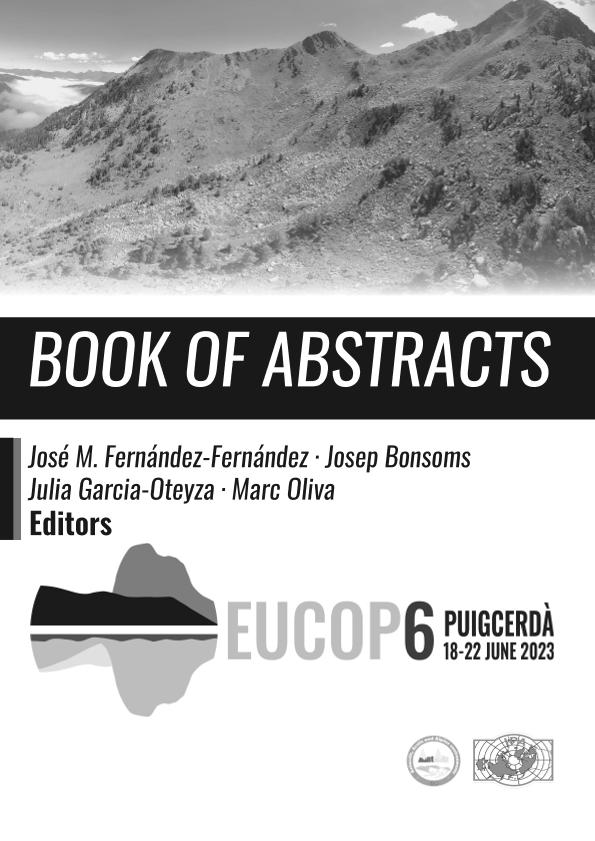Evento
Springs from cold rocky landforms: icy seeps in warming mountains
Brighenti, Stefano; Millar, Constance; Colombo, Nicola; Benech, Andrea; Canturan, Luca; Lencioni, Valeria; Scotti, Alberto; Tolotti, Mónica; Bruno, Maria C.; Janicke, Andrina; Fischer, Andrea; Gschwentner, Andrea; Hayashi, Masaki; Reato, Agustina ; Hotaling, Scott; Tronstad, Lusha Marguerite; Finn, Debra; Herbst, David; Larsen, Stefano; Comiti, Francesco
; Hotaling, Scott; Tronstad, Lusha Marguerite; Finn, Debra; Herbst, David; Larsen, Stefano; Comiti, Francesco
 ; Hotaling, Scott; Tronstad, Lusha Marguerite; Finn, Debra; Herbst, David; Larsen, Stefano; Comiti, Francesco
; Hotaling, Scott; Tronstad, Lusha Marguerite; Finn, Debra; Herbst, David; Larsen, Stefano; Comiti, Francesco
Colaboradores:
Fernandez Fernandez, José M.; Bonsoms, Josep; García Oteyza, Julia; Oliva, Marc
Tipo del evento:
Congreso
Nombre del evento:
6Th. European Conference of Permafrost
Fecha del evento:
18/06/2023
Institución Organizadora:
Universidad de Barcelona. Departamento de Geografía;
Título del Libro:
Books of Abstracts of the 6Th. European Conference of Permafrost
Editorial:
Universidad de Barcelona
Idioma:
Inglés
Clasificación temática:
Resumen
The decline of cold environments is among the major effects of climate change. In mountain areas, freshwater habitats have been warming as a result of increasing air temperature, reduction of the snowmelt period, and glacier recession. However, most high-mountain regions contain landforms composed of coarse rocky materials and often containing ice, that are thermally buffered, and sustain cold/cool habitats in otherwise unfavourable climatic conditions. These cold rocky landforms, often originate very cold springs (< 2 °C), termed icy seeps, that might represent climate refugia for coldadapted aquatic organisms. Rock glaciers appear to be the most common source of icy seeps, but other mountain landforms including debris-covered glaciers, morainal deposits, talus slopes, and protalus ramparts can support similarly cold springs. Collectively, icy seeps have been understudied, and little is known about how their thermal regimes vary among types of icy seep and across major mountain ranges. We monitored summer water temperature (mostly 2021/2022) of 152 springs across 14 mountain areas of the Eastern and Western European Alps, Rocky Mountains, Great Basin Mountains, and Patagonian Andes. The monitored springs represented icy seeps from rock glaciers, morainal deposits, talus slopes, protalus ramparts, and debris-covered glaciers, plus reference springs originating from slopes composed of fine materials with diverse origins. Thermal conditions at the same spring types differed among mountain ranges, but icy seeps were consistently colder (by 0.5 – 6.0 °C) than reference springs located within the same catchments, and at comparable elevations. This thermal offset was positively correlated with spring elevation, slope aspect, and average clast size of the landform debris. Our results highlight that major geomorphological drivers are useful for identifying some mountain features as cold rocky landforms for aquatic habitats. Hydroecological research on these environments is needed to address management strategies for climate change adaptation.
Palabras clave:
Cold environments
,
Climate change
,
Aquatic habitats
Archivos asociados
Licencia
Identificadores
Colecciones
Eventos(CIEMEP)
Eventos de CENTRO DE INVESTIGACION ESQUEL DE MONTAÑA Y ESTEPA PATAGONICA
Eventos de CENTRO DE INVESTIGACION ESQUEL DE MONTAÑA Y ESTEPA PATAGONICA
Citación
Springs from cold rocky landforms: icy seeps in warming mountains; 6Th. European Conference of Permafrost; Puigcerdà; España; 2023; 121-121
Compartir
Altmétricas



